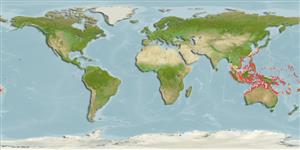Common names from other countries
>
Acanthuriformes (Surgeonfishes) >
Siganidae (Rabbitfishes)
Etymology: Siganus: Latin, siganus = a fish, rabbit fish; by the similarity of the nose (Ref. 45335).
More on author: Schlegel.
Environment: milieu / climate zone / depth range / distribution range
Οικολογία
Θαλασσινό(ά) Υφαλόφιλο(α); εύρος βάθους 1 - 30 m (Ref. 9710), usually 2 - 30 m (Ref. 27115). Tropical; 22°C - 27°C (Ref. 27115); 32°N - 25°S, 97°E - 174°W
Indo-West Pacific: Cocos-Keeling Islands and the South China Sea to the Gilbert Islands, north to the Ryukyu Islands, south to the southern Great Barrier Reef and New Caledonia (Ref. 37816).
Μέγεθος / Βάρος / Age
Maturity: Lm ? range ? - ? cm
Max length : 38.0 cm TL αρσενικό/απροσδιόριστο; (Ref. 2334); common length : 25.0 cm TL αρσενικό/απροσδιόριστο; (Ref. 9813)
Ραχιαίες άκανθες (συνολικά) : 13; Μαλακές ραχιαίες ακτίνες (συνολικά) : 10; Εδρικές άκανθες: 7; Μαλακές εδρικές ακτίνες: 9; Σπόνδυλοι: 13. Body yellow-orange above to silvery white below; a prominent blackish bar on head, spotted; iris blackish; opercular area silver; dorsal and anal fin spines and rays yellow, spines with white streak. Spines stout and venomous. Preopercular angle 101°-111°. Cheeks fully covered with strong scales. Midline of thorax scaled; scaled pelvic ridges may interrupt scale row pattern. Low rim of anterior nostril expanded posteriorly into a short, broad triangular flap.
Occurs in shallow, coral-rich areas of clear lagoons and seaward reefs. Individuals up to 7 cm SL forms large schools in shallows, lagoons and outer reef flats, particularly in areas dominated by luxurious growths of Acropora. Adults occur in pairs. Juveniles feed on filamentous algae, adults on algae, tunicates, and sponges (Ref. 9813, 48637). Can inflict painful stings (Ref. 4690).
Life cycle and mating behavior
Maturities | Αναπαραγωγή | Spawnings | Egg(s) | Fecundities | Προνύμφες
Woodland, D.J., 1990. Revision of the fish family Siganidae with descriptions of two new species and comments on distribution and biology. Indo-Pac. Fish. (19):136 p. (Ref. 1419)
IUCN Red List Status (Ref. 130435)
CITES (Ref. 128078)
Not Evaluated
Human uses
αλιεία: περιορισμένης εμπορικότητας; Ενυδρείο: Εμπορικό(ά)
Εργαλεία
Special reports
Download XML
Διαδικτυακές πηγές
Estimates based on models
Preferred temperature (Ref.
115969): 24.7 - 29, mean 27.7 (based on 722 cells).
Phylogenetic diversity index (Ref.
82804): PD
50 = 0.5000 [Uniqueness, from 0.5 = low to 2.0 = high].
Bayesian length-weight: a=0.01230 (0.00706 - 0.02143), b=2.98 (2.83 - 3.13), in cm Total Length, based on LWR estimates for this species & Genus-body shape (Ref.
93245).
Τροφικό Επίπεδο (Ref.
69278): 3.0 ±0.00 se; based on food items.
Ελαστικότητα (Ref.
120179): Υψηλό, ελάχιστος χρόνος για διπλασιασμό πληθυσμού < 15 μήνες (Preliminary K or Fecundity.).
Fishing Vulnerability (Ref.
59153): Low to moderate vulnerability (28 of 100).
